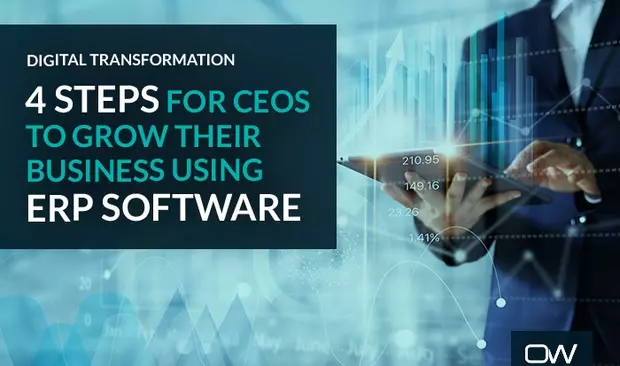Four steps for CEOs to grow their business using ERP software

As a CEO, are you looking to make digital changes in your business, but feel bogged down by the thought of such a big investment?
You’re not alone. Roughly, 36% of CEOs are the biggest obstacle for digital transformation in a business. With such a big decision on your hands, we understand why.
Find out how to gain the confidence to invest in software for your business with these four steps:
1. Don’t pay attention to the software your competitors are implementing
A recent survey found that 75% of chief officers have a fear of disruption from data-driven, digital competitors. In a bid to stand out, it’s common for CEOs to rush into a technology investment without doing due diligence on whether it’s right for the business.
If you have chosen the same software as a competitor in previous years and it hasn’t worked out, you’ll know how much it can rock your confidence in finding a suitable replacement. With this in mind, you don’t want to put a wrong foot forward by investing in inefficient software to try and beat the competition.
It’s important to remember what works for your biggest competitor won’t necessarily work for your business. Instead of focusing on what software is being implemented elsewhere, consider Step 2.
2. Work out your business struggles
To work out which software is right for you, you first need to assess your day-to-day struggles in the business. For example, a shocking 67% of senior managers are not comfortable accessing their data. This creates too much guesswork, making it impossible for you to know whether your business is coming or going.
In a recent report about the role of a CEO, it stated that “CEOs find it difficult to identify, match, combine, and orchestrate resources to meet demands from stakeholders.” By not having the technology to manage employees efficiently, it can be hard to see their true potential and even cause you to develop a lack of trust in your workforce.
Drill down into each aspect of your business to find out what you have the answers to and what you don’t. Can you pull together business statistics when you need them? Are you using your staff to their greatest capabilities? Once you figure out what’s working and what isn’t, you will build a clearer picture for Step 3.
3. Do your research
Risks associated with implementing ERP software are mainly down to the lack of research that businesses conduct before acquiring a new solution. As the website Software Suggest puts it, “you can increase the probability of a successful project by selecting an efficient vendor.” To prevent a repeat of history, you need to do your groundwork and establish what your business requires from a new solution.
The easiest way to do this is to flip over those pain points that you worked out earlier. For example, if you distinguished that there’s too much guesswork for management, you know that a business intelligence solution is essential for growth. Be clear about the items you need and the items you don’t from your new ERP software.
4. Have confidence in your software implementation and believe in it
The most important step is to have confidence in your decision. Despite all the rumours, success rates in ERP implementation are high, with a recent study highlighting that “two thirds (67%) of [their] participants rate their implementation as successful or very successful and only one out of 315 described theirs as a failure”. Further findings in this study show that driving the onboarding process with passion is key, with support and commitment from upper management was voted as the top reason for successful ERP implementation at 62%.
So, sit back and have the confidence in implementing your new ERP software. Before you know it, you’ll be reaping results that you never thought were possible.